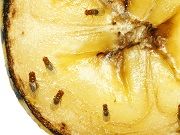Article
Fruit Flies Shed Light on HPV-Induced Cervical Cancer
Author(s):
Research reveals potential drug targets for cervical cancer associated with human papillomavirus.

The first fruit fly model of a virus that mimics human papillomavirus (HPV)-induced cervical cancer has been developed, and may help researchers better understand the underlying mechanisms of how the virus can cause cancer.
Prior studies that used mouse and human cells have shown that HPV enters the body through the skin, and produces several oncoproteins. These proteins are able to turn a normal cell into a tumor cell, and one viral oncoprotein in particular, called E6, plays an important role during the later stages of tumor formation and metastasis.
During the newest study, published in PLOS Pathogens, researchers introduced the viral E6 oncoprotein, as well as a human protein required for E6-induced cancer into fruit flies.
“This is the first model of an HPV-induced cancer in fruit flies,” said researcher Bing Zhang. “This new model will help scientists understand the molecular and biochemical pathways involved in tumor growth and malignancy caused by HPV as well as screen for potential drug targets.”
Researchers found that the proteins caused severe abnormalities in the epithelial cells of the fruit flies and that there were reduced levels of the same suite of proteins that are targeted by E6 in humans. When the fruit fly version of the E6-targeted proteins was used in human cell lines, the results of the study showed that it had similar results, therefore, providing further evidence that E6 works the same in both flies and humans.
“The take home message is that the same key molecular players that underlie HPV E6-mediated cancer in humans do the same things in flies,” said lead researcher Mojgan Padash. “Practically speaking, this means we can now use this fly model to identify other essential components that contribute to E6-mediated tumorigenesis, which has the potential to translate into therapies for HPV-induced cancers.”
Although there were cellular abnormalities, researchers found that the E6 protein was not sufficient enough to cause tumors in flies. To correct this, researchers introduced a third protein called Ras into the flies, since it’s thought that mutations in a human Ras protein may contribute to E6-mediated tumor development in humans.
“The model that has been developed has been used to identify other essential pathways that contribute to E6-driven malignancy,” said study co-author Lawrence Banks. “The power of this model is that it can be used now to screen for inhibitors of other pathways, which have the potential to translate into therapies for HPV-induced cancer.”
HPV is the most common sexually transmitted infections in the United States, and has been identified as a cause of cancer in women.






